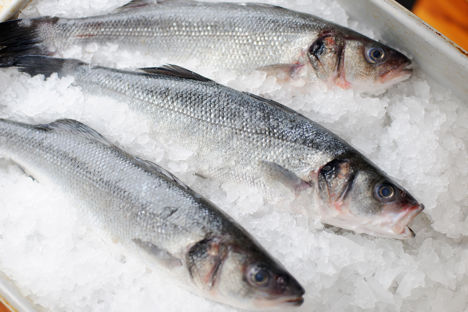Sea bass is a natural beauty of a round fish that has long been a favourite with chefs, thanks to its elegant silvery skin and meaty yet silky flesh. Although it isn’t classed as an oily fish, it is fairly fatty for a white fish and is a good source of omega-3. This makes it a relatively healthy choice. Unlike more delicate white fish, sea bass is quite robust and holds its shape well after cooking, it has a mild taste with a hint of sweetness which means it works well with bold ingredients as well as matching with more subtle flavours.
Sea bass is great served whole, as well as in fillets or even sliced and cured as a carpaccio. Read on for tips on what to consider when buying sea bass, as well as instructions on how to prepare and cook it to get the best from the fish.
What should I look for when buying sea bass?
Wild sea bass numbers are at very low levels so buy responsibly farmed sea bass where possible. To know the sea bass is fresh, look for fish with clear eyes, intact fins and bright red gills. The fish should be firm to the touch and free of any unpleasant, strong fishy smell. It can be harder to tell how fresh sea bass fillets are, but look for pearly white flesh with no discolouration.
Can I freeze sea bass?
Fresh sea bass will keep in the fridge for 2-3 days, but if you don’t plan to cook your fish within this time then it can easily be frozen and will keep this way for up to 3 months. You can pop fillets or whole (scaled and gutted) fish in a sealed bag or box in the freezer. But if you want to keep your sea bass at its absolute best, and avoid the fish drying out, then try this top tip: Take a zip-loc bag that is the right size for your fish, pour in enough water to submerge the fish, along with a pinch of salt, seal and freeze.
To defrost your sea bass allow it to thaw slowly, in the fridge, for about 24 hours, before cooking.
Sea bass is a great fish for serving whole. To treat it this way, trim the tail and fins, if they are still attached, using sharp kitchen scissors. Pat the skin dry with kitchen roll and season both the outside of the fish and inside the cavity (where the guts and gills have been removed). You might want to score the skin before cooking, to allow heat and flavours to penetrate more effectively.
If you want to fillet sea bass yourself, cut off the spiky bones and fins then make a cut behind the head, through the gills, to take the gills and head off. With a sharp knife, smoothly score down the back of the fish slightly to the left off the back bone, running along the length of the fish until you meet the spine. Then pull the first fillet back and angle your knife towards the bone, making gentle sweeping strokes to take the fillet off.
Roasting whole sea bass in the oven is a great method for feeding a group as it needs very little prep and removes the stress of cooking multiple fillets to order. Try our simple recipe for lemon and herb infused whole baked sea bass.
Metric
Imperial
- 1 whole sea bass, about 1.5-1.8kg/4lb, gutted and scaled
- 1 tbsp of extra virgin olive oil
- 2 lemons, thinly sliced into rounds
- 1 handful of thyme sprigs
Preheat the oven to gas 220C/200C fan. Wash the sea bass and pat dry with kitchen roll and cut 3-4 slashes across the flesh of the fish. Rub the skin with the oil and season inside and out
- 1 whole sea bass, about 1.5-1.8kg/4lb, gutted and scaled
- 1 tbsp of extra virgin olive oil
Line a large baking sheet with foil or baking paper, lay half the lemons over the sheet then lay the fish on top
- 2 lemons, thinly sliced into rounds
Stuff the cavity of the sea bass with the rest of the lemon slices and all of the herbs. Bake for about 30 mins, or until the flesh is opaque and white in the thickest part. Rest for a few mins before serving
- 1 handful of thyme sprigs
- 2 lemons, thinly sliced into rounds
Can I BBQ whole sea bass?
Whole sea bass is great on the BBQ, just brush with oil and place onto lemon or orange slices on the grill to stop the skin from sticking. Alternatively cook straight on the bars of the grill, to get a nice charred effect, as Dominic Chapman does with his recipe
How do I cook sea bass fillets?
Pan frying fillets of sea bass is a great quick way to cook the fish, giving tasty results. The key is not to overcook the fish. To pan fry sea bass fillets, brush a frying pan with a little oil, then fry the fish over a medium-high heat, skin-side down, for 3-4 mins. Reduce the heat, brush the sea bass flesh with a little more oil then flip and cook for 1-2 mins until just cooked through. Check out or video to follow step-by-step how to pan fry sea bass fillets or try our delicious recipe by chef Matt Worswick.
Sea bass fillets can also be roasted in the oven, added to the top of veg on a traybake for the last 5-10 mins of baking. To lock in moisture cook fillets en papillote – wrapped in a foil or baking paper parcel – with butter or oil and flavourings such as herbs, citrus or fragrant veg like fennel or spring onions. Or try steaming with lots of Chinese spices and flavourings as Shaun Hill does.
What to eat with sea bass?
With its delicate yet meaty flesh, and richly flavoured skin, sea bass is brilliant with strong and punchy flavours such as the tomato, olive and herb combinations loved in the Mediterranean, as well as the umami-rich, sweet and sour sauces and aromatics in Asian cooking. Herbs that go with sea bass include thyme, oregano, parsley, and basil.
Try serving sea bass with noodles, rice, Asian broth and veg, or mashed or roasted potatoes or other roots. Or for something a little different match it with Indian spices and a mouthwatering tamarind-based sauce as Yottam Ottolenghi does with his inspired recipe.
Get in touch
Please sign in or register to send a comment to Great British Chefs.



